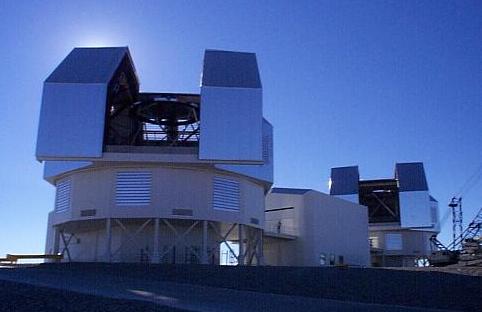
University of Toronto Time on the 6.5m Magellan Telescopes
Volume 33, Number 3
November 2002



I begin this editorial with apologies for its tardiness. The first issue
following the loss of its most important staff member is often delayed. We
will improve, but Mike Allen, who played a key role as editor, is difficult to
replace. He did a memorable job of keeping things in order and in proper
perspective. During his tenure as editor, Mike managed to teach one of the
popular, populous courses, take care of all the DDO tours, keep the DDO network
running smoothly and raise family including a pair of twins. Mike has moved
to a continuing position at Washington State University. Best wishes, Mike,
and thanks.
The Department of Astronomy and Astrophysics has entered into a collaborative arrangement with the Carnegie Institution of Washington in order to develop instrumentation for use on the 6.5m Magellan Telescopes. As part of this arrangement, a number of nights on the Magellan telescopes are available for use by University of Toronto astronomers. The Magellan telescopes are sited at Las Campanas, Chile (one of the finest observing sites on the planet). Commissioning of Magellan I (the Baade Telescope) is now complete and commissioning of Magellan II (the Clay Telescope) is underway and expected to be completed by the end of the year.
Sixteen nights will be available to U of T astronomers on both Magellan Telescopes from Jan 10, 2003 to July. 20, 2003. Proposals are now invited for use of this time.
Please refer to http://www.ociw.edu/magellan_lco/instruments/ for specific information. However, do take note of the following Exciting New Instruments a subset of which is likely to be available:
The upcoming semester is going to be difficult for Carnegie to schedule owing to the commissioning of these instruments, but the instrument load (provisionally specified at the recent SAC meeting) is summarized below. If an instrument appears in both columns it is expected to swap telescopes partway through the semester.
________ Magellan Semester 2003A ________
| ____BAADE____ | ____CLAY_____ |
|---|---|
| IMACS* | LDSS2 |
| - | MagIC** |
| B&C | B&C |
| MIKE | MIKE |
| PANIC | PANIC** |
* - from May'03
** - Folded port
In addition, MIRAC (a mid-infrared instrument) may be offered in collaboration with Arizona (if you're thinking of applying talk to me first).
(2) The Principal Investigator for the Magellan proposal must be a faculty member in the Dept of Astronomy & Astrophysics, or a postdoc in the department. CITA postdocs are also welcome to PI proposals, but should do so in collaboration with a faculty member. Students are also welcome to apply via a faculty member.
(3) Non-University of Toronto co-applicants (but not PI's) are certainly acceptable (and especially welcomed if they leverage additional time at comparable facilities), but in this case the program of investigation must be very actively lead by someone in the department.
(4) If you are awarded time you are *personally* on the hook for any and all expenses related to the proposal. These do not come from departmental funds. In addition to airfare, expect to pay US$40/night for accomodation at the telescope, in addition to sundry other expenses. Please be aware that these sundry expenses can add up to significant sums. For example, OCIW will charge US$50 to cut each LDSS mask on their milling machine, so one can quite easily rack up a $1000 bill for masks alone to cover a 2 night LDSS run.
(5) Time allocation will be decided at a meeting scheduled at the end of October (time TBD). The time allocation committee will be comprised of those faculty members who have applied for time, plus the Department Chair. In other words, if you apply for time, you should attend the meeting that disburses the time, and if necessary be prepared to argue your case. It is understood that everyone attending the meeting will have read all the proposals submitted.
(6) Proposals should be submitted directly to me (electronically or via hardcopy) by the deadline. I will make photocopies of the proposals and ensure that every faculty member who applies (and Peter) gets a copy of all submitted proposals.
(7) The application process will continue to evolve as required. Please send suggestions to me.
As our illustrious president is off observing and cutting masks (aka, arts and crafts), the duty of drafting a delectable DOINGS article has fallen upon your not-so-illustrious GASA secretary.
In the last few months, we have seen many changes in the student population of the department: qualifying exams and PhD defences; students arriving and Doctors leaving. Congratulations are due to Jennifer Karr, Tracy Webb, Chuck Shepherd, Jenna O'Neill and Isamu Matsuyama. And good luck to the many who will be joining their circle (or more accurately, their pentagon) in the near future. May your corresponding examinations and defences go well.
GASA would like to officially welcome all the new students -- about whom you can read in another article of this publication. It appears that the Graduate Astronomy Students Association will be in good hands for years to come!
And this just in...
GASA elections were held on November 20th, and the results you have all been waiting for are in.
President: Preethi Nair
Secretary: Carrie Bridge
Treasurer: Brian Lee
Friend of the editor: Martin Durant
Juice: Paula Ehlers
Newspaper: Preethi Nair
Discussion Group: Mark Brodwin, Kris Blindert, Rosemary McNaughton
Coffee Drudge: Paula Ehlers
Colloquium: Tingting Lu
Computer Rep.: Tornado
Sports: Marcelo Ruetalo
Sun Angles: John Liska, Lawrence Mudryk, Megan McClure
Hiring Committee: Brian Lee
Desks: John Liska
GSU-rep: Martin Durant
Health/Safety: Megan McClure, Jenna O'Neill
Tea: Lawrence Mudryk
Web Committee: Lawrence Mudryk
Plants: Lawrence Mudryk
Non-GASA elections:
mini-courses: Kevin Blagrave
union steward: Paula Ehlers
colloquium selection: Kris Blindert, Lawrence Mudryk, Lihong Yao
CARRIE BRIDGE
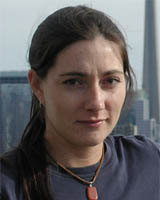 I grew up in a number of small towns throughout Southern Ontario, so I set out to experience city life and went to the University of Toronto. I spent my first year at Erindale at which time I was majoring in Human Biology. However I saw the light, moved to the St.George campus, and changed my major to astronomy and physics in which I obtained my BSc. Over the past year and currently I have had the opportunity to work with Ray Carlberg, along with Pat McCarthy of Carnegie, on projects involving photometric and spectroscopic redshifts, and observing for the Las Campanas IR Survey. My main research interests lie in observational cosmology, galactic formation, evolution and clustering. Outside the office, I enjoy skiing, volleyball, and spending time at my cottage.
I grew up in a number of small towns throughout Southern Ontario, so I set out to experience city life and went to the University of Toronto. I spent my first year at Erindale at which time I was majoring in Human Biology. However I saw the light, moved to the St.George campus, and changed my major to astronomy and physics in which I obtained my BSc. Over the past year and currently I have had the opportunity to work with Ray Carlberg, along with Pat McCarthy of Carnegie, on projects involving photometric and spectroscopic redshifts, and observing for the Las Campanas IR Survey. My main research interests lie in observational cosmology, galactic formation, evolution and clustering. Outside the office, I enjoy skiing, volleyball, and spending time at my cottage.
TINGTING LU
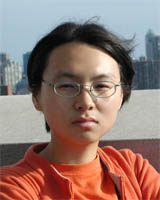 I am Tingting. After I got a BS in Astronomy at Peking University this year, I came here to begin my study in the direct entry PhD program.
I am Tingting. After I got a BS in Astronomy at Peking University this year, I came here to begin my study in the direct entry PhD program.
I am very interested in cosmology, general relativity and black holes etc. I also have interest in high energy astrophysics and theoretical physics. Now I am working on weak lensing, which is my first project, under the direction of professor Ue-Li Pen.
Reading books, such as scientific fictions, knight-errant novels, cartoons, humanistic books (like philosophy, history and society), is what I like to do in my spare time. I also like music (especially pop, new age and film music) and movies.
ADAM MUZZIN
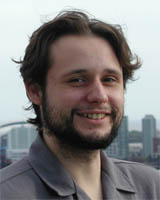 Many of you might recognize me because I've been at U of T for 4 years already, doing my bachelor's degree. During this time I've worked three summers with Christine Clement on a variety of variable star projects. I did my fourth year project with Henk Hoekstra working on a method for measuring galaxy shapes. I am currently doing my first project with Henk on some weak lensing related topics. I live with my amazing girlfriend Suzanne who many of you know, as well as my very cute and very evil African Grey Parrot named Jaco (Jaco Pastorius is the greatest bass player of all time, no the bird doesn't play bass, yes he screams...).
Many of you might recognize me because I've been at U of T for 4 years already, doing my bachelor's degree. During this time I've worked three summers with Christine Clement on a variety of variable star projects. I did my fourth year project with Henk Hoekstra working on a method for measuring galaxy shapes. I am currently doing my first project with Henk on some weak lensing related topics. I live with my amazing girlfriend Suzanne who many of you know, as well as my very cute and very evil African Grey Parrot named Jaco (Jaco Pastorius is the greatest bass player of all time, no the bird doesn't play bass, yes he screams...).
Currently I'm reading James Joyce's Ulysses which is the greastest book I've ever read (and I'm not done). Musically, I'm a Pink Floyd, Primus, Frank Zappa kinda guy. I came here from Hamilton which is not too far away (you can probably smell it from here) so I feel pretty much at home in the Toronto area.
MARTIN DURANT
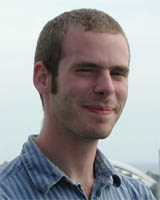 I am from Manchester (as in United) and studied at Trinity College, Oxford. This is my first year here, and I am still busy investigating the city and learning to talk Canadian.
You'll find me in the office daytimes and always ready for a tea break. I take my work seriously, but I am able to leave it behind in the office and relax.
I am from Manchester (as in United) and studied at Trinity College, Oxford. This is my first year here, and I am still busy investigating the city and learning to talk Canadian.
You'll find me in the office daytimes and always ready for a tea break. I take my work seriously, but I am able to leave it behind in the office and relax.
I-HUI (TORNADO) LI
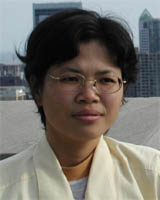 Long long time ago, there was a saying, "Tornado will go to Toronto to eate potato and tomato." Now Tornado in Toronto seldom buy potato and tomato...
Long long time ago, there was a saying, "Tornado will go to Toronto to eate potato and tomato." Now Tornado in Toronto seldom buy potato and tomato...
My name is Tornado. Don't be stunned. You don't get the wrong spelling. Tornado, the twister. I am from Taiwan with my little bear and my little dog. I wish someday my little bear and I can travel to the polar region to make friends with polar bears.
My interests in Astronomy are broad, mainly on larger scales, such as galaxies, large scale stuctures and cosmology. All of my previous works were on galaxies. Here, I start my first project with Howard Yee, studying the evolution of infalling galaxies in cluster environment. I am glad people here are kind and ready to give a hand. I am also glad there are some swings near the campus.
No matter how sad the beginning, this story should have a happy end....
FLORIAN LEDER
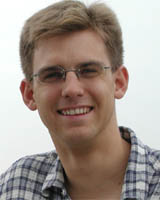 Hi, I'm an exchange student from Karlsruhe, Germany and will be in
Toronto for approximatly one year. Even though I've spent the past 14
years of my life in Germany, I am Austrian and was born in Switzerland.
Back home, I've studied Physics and Mathematics for 3 years. I've always
wanted to spend some time abroad during my studies and was facinated by
astrophysics, expecially cosmology and gravity. One day, I asked my
teacher, Prof. Frans Klinkhammer, where to go and he said CITA/UofT...
therefore, here I am. At the moment I'm taking part in the collaborative
program, but I would like to do some research during the winter or
summer term.
Hi, I'm an exchange student from Karlsruhe, Germany and will be in
Toronto for approximatly one year. Even though I've spent the past 14
years of my life in Germany, I am Austrian and was born in Switzerland.
Back home, I've studied Physics and Mathematics for 3 years. I've always
wanted to spend some time abroad during my studies and was facinated by
astrophysics, expecially cosmology and gravity. One day, I asked my
teacher, Prof. Frans Klinkhammer, where to go and he said CITA/UofT...
therefore, here I am. At the moment I'm taking part in the collaborative
program, but I would like to do some research during the winter or
summer term.
Besides my studies I like snowboarding in the winter and riding my
motorbike in the summer (but I sold it before I left Germany). During
the school year I enjoy working out, swimming, dancing, and going out
with friends.
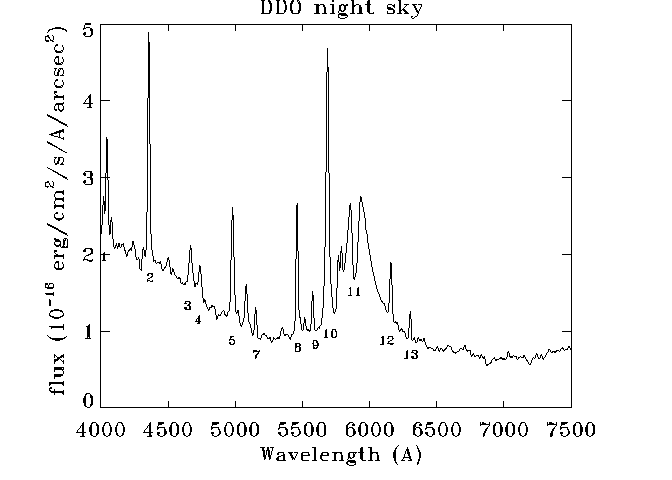
A spectrum of the Toronto sky was obtained on May 26/27, 2002 by Michael De Robertis, Robin Fingerhut and Mel Blake of York University. Jim Thomson was the Telescope Operator.
The weather conditions were very good, but with a full Moon. The data were taken at 4:50 UT at the location: RA=12:07, dec=+39:41, HA=+3:45, AM=1.33. The spectrum was obtained with the 100 lines/mm grating giving the spectral scale of 3.65A/pixel. It was transformed to absolute units using stellar photometric standards. The accuracy of the calibration is estimated at about 30-40%. The calibration is much better in the relative sense, at the level of 10%.
The main identified emission features in the spectrum are marked by numbers. "Hg I" denotes the mercury lamp lines, "Na I" the sodium lines (HPS and LPS for high and low pressure lamps), while "airglow" lines come from the natural sky emission which is related to the auroral light. The wavelengths are in Angstroms. Some of the features may be due to the metal halide bands.
Note the increase to the blue which is due to atmospheric scattering. In spite of the heavy light pollution, some parts of the spectrum are relatively dark. Note the dark region around 5300A, not far from the centre of the V-band at 5550A. The sky brightness in this region is 18.4 mag/square-arcsec. However, the strong HPS feature between 5500A - 6500A provides as much as 40% of the sky background for >5300A elevating the sky brightness to the level of 17.5 mag/square-arcsec. This was independently verified by broad-band photometry with the unfiltered ST-6 camera on the 6-inch finder. The wide, heavily contaminated ST-6 band corresponds approximately to the R-filter. These measurements gave 16.8 - 17.0 mag/square-arcsec for the equatorial sky over Toronto which is distinctly brighter than the spot used for the sky spectrum described above.
Slavek Rucinski, July 2002, with thanks to the York team for permission to make these results available.
(Ed. - you might find it interesting to compare these observations with ones made back in 1978 from the downtown campus observatory by Lane & Garrison, J. Roy. Astron. Soc. Can. Vol. 72, No. 4, p.198)
The dome is on the building and the telescope is installed. Digital images of the installation arrived here in the evening of the same day and are included here. The nearest towns are 220 km distant over rough mountain roads, so renting the crane was a problem. San Juan (headquarters), Mendoza and El Leoncito form a nearly equilateral triangle.
This is Spring in Argentina, so there should be lots of progress, with dedication at the end of their Summer.
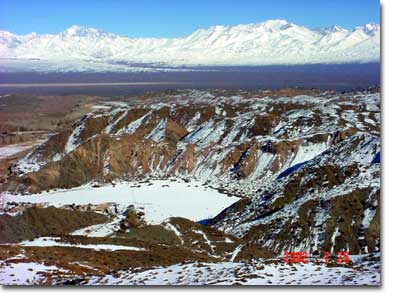 < Figure 1. The view of the Andes from Burek, the new
home of HSHT.
< Figure 1. The view of the Andes from Burek, the new
home of HSHT.
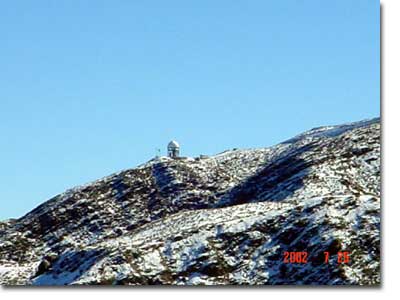
Figure 2. >
A telephoto view of the HSHT on Burek
(2800 m) taken from the site of the Argentine CASLEO 2.15-m telescope
(2200 m). A new 7-km road covers the 2-km line-of-sight distance between
the telescopes.
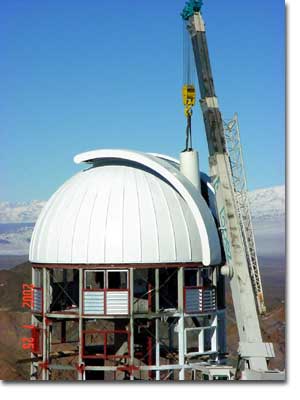 < Figure 3.
< Figure 3.
The HSHT enters her new home.
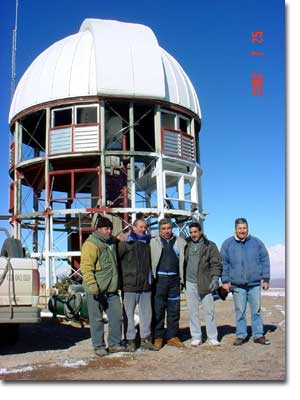 < Figure 4.
< Figure 4.
Engineers and technicians are ready to
celebrate a good job well done.
In my work with the IAU and other organizations, I enjoy finding out how astronomy education and outreach are done in other countries. This summer, I got to broaden my understanding of astronomy education in Europe, and the excellent work which is done by the European Association for Astronomy Education (EAAE). And my wife Maire got to revisit the country of her roots. I was Keynote Speaker at the Sixth Annual Summer School of EAAE. It was held in the second week of July, in Enontekio, in northern Finland -- the land of reindeer, mosquitos, and the Midnight Sun. Despite the numerous warnings, the mosquitos failed to materialize, apparently because the weather had been so dry. But a hundred teachers and teacher educators did materialize, from all over Europe. The Organizing Committees were headed by Rosa Maria Ros (Spain) and Irma Hannula (Finland). The school consisted of a dozen intensive workshops, all of them related in some way to the sun. As much hands-on activity as possible was scheduled, though the sun did not always conform to the schedule. A complete set of workshop notes (some in two or three languages) was provided to each participant. There was a poster session, and a "swap shop", at which teachers could share their ideas and resources in a formal way. There were interesting outings to the prehistoric rock paintings at the northern tip of Norway, to the local museum for a sampling of Sami (aboriginal) culture and a stunning presentation on The Northern Lights, and to a local reindeer farm. [Based on this one experience, I got the impression that reindeer farmers are a lot like western cowboys]. There was lots more socializing, and sharing of experiences, over mountains of excellent Lapland food. I commend the EAAE, and especially Rosa Maria Ros, for organizing these schools which spread astronomy, and astronomy teaching, into the countries of Europe so effectively.
The Erindale Campus (now properly known as the University of Toronto at Mississauga) is growing rapidly as part of the university's response to the double cohort. With the abolition of "grade 13" in Ontario, there will be two graduating years from high school, both arriving in 2003. But many students have fast-tracked, and the university has responded by increasing enrolment. Erindale is one massive construction site, as new additions, and whole new buildings go up.
Some of you may know that I have developed an undergraduate minor program in Science Education, with a core course SCI398Y (Science Education) and a fourth-year project course. The core course doubled in size this year, to 30 (which was an upper limit which I placed on the course). The project course had two students last year (its first year); now it has ten. We are now planning for a partnership program with OISE/UT, where the teacher education programs reside. This program is based on the Early Teacher Project, pioneered by Charles Dyer at Scarborough.
On October 4, award-winning Toronto science writer Dan Falk launched his book "Universe on a T-Shirt", published by Penguin. Canadian astronomy books are rare; Canadian astronomy books not written by Terry Dickinson are even rarer. This one follows the quest for a "theory of everything" from Greek times to the present. It's broad, philosophical, and well-written. Just in time for Christmas.
Two new books have appeared which I commend to you: Learner-Centered
Astronomy Teaching: Strategies for ASTRO 101 by Timothy F. Slater and
Jeffrey P. Adams, and Lecture-Tutorials for Introductory Astronomy, by
Adams, Edward E. Prather, and the Conceptual Astronomy and Physics
Education Research Team. Both are published by Prentice-Hall. Some of
you remember Tim Slater's lecture and workshop when he visited here a
couple of years ago, so you are aware of Tim's dynamic style, and the
importance of his message. Every teacher of introductory astronomy
should have, understand, and use this material. Copies of both of
these books are in the DAA library.
This is a short report on the activities at the DDO in DDO July 1,2001 - June 30,2002. The statistical data are related to the previous two years.
This year was a relatively quiet one at the DDO with only one major problem (a fire in the generator room, 8 nights lost) and with the record number of actually used hours: 1059.
Here is a comparison for the 3 last years, counting a report year from July 1 to June 30.
1999-2000 2000-2001 2001-2002 Comment
Nights scheduled 294 315 332
Nights used 151 168 188
Used / scheduled (%) 51 53 57 1
Total hours 888 986 1059
Average obs night (h) 5.6 5.6 5.9 2
Efficiency (%) 26 28 31 3
Comments:
The publication record is: 8 in 2001, 1 in 2002 with currently 12 in press.
The fourth conference on Library and Information Services in Astronomy (LISA IV), was held July 2-5, 2002, in Prague, Czech Republic, just weeks before the devastating floods there.
The conference brought together almost one hundred librarians, astronomers, publishers, and computer specialists. Panels, papers and posters detailed methods of dealing with the vast changes librarians and other information professionals are facing today, not only in methods of information delivery and the kinds of information being delivered, but also in innovations in preserving and presenting to users older and historical materials.
I chaired a panel and presented a paper on 'Physical Libraries vs Virtual Libraries'.
As was the case with previous LISA conferences, a "Friends of LISA (FOL)"
committee began fundraising more than a year prior to the conference.
The committee (as before) consisted of Marlene, Ellen Bouton (NRAO),
Brenda Corbin (USNO), along with Ron Enders. FOL raised sufficient
funds from publishers, institutions, and individual librarians to assist
a record 29 librarians from 12 developing countries. The presence of
these colleagues greatly enriched the meeting for all attendees; FOL
grantees were enthusiastic participants in the conference and will most
certainly have much to share in their home institutions and countries.